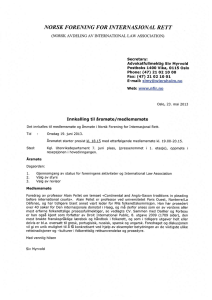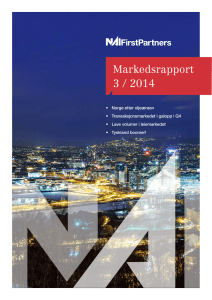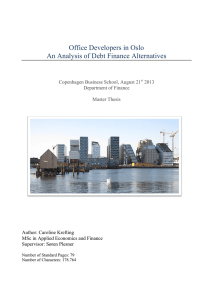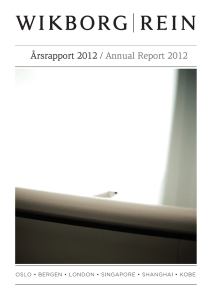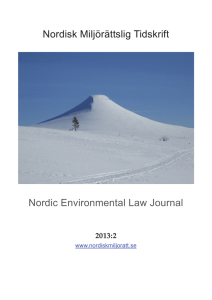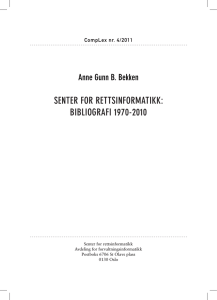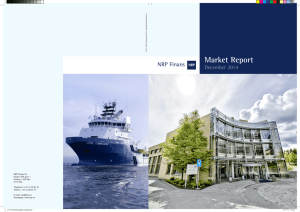Foundations and space of action of Nordic inheritance law
advertisement
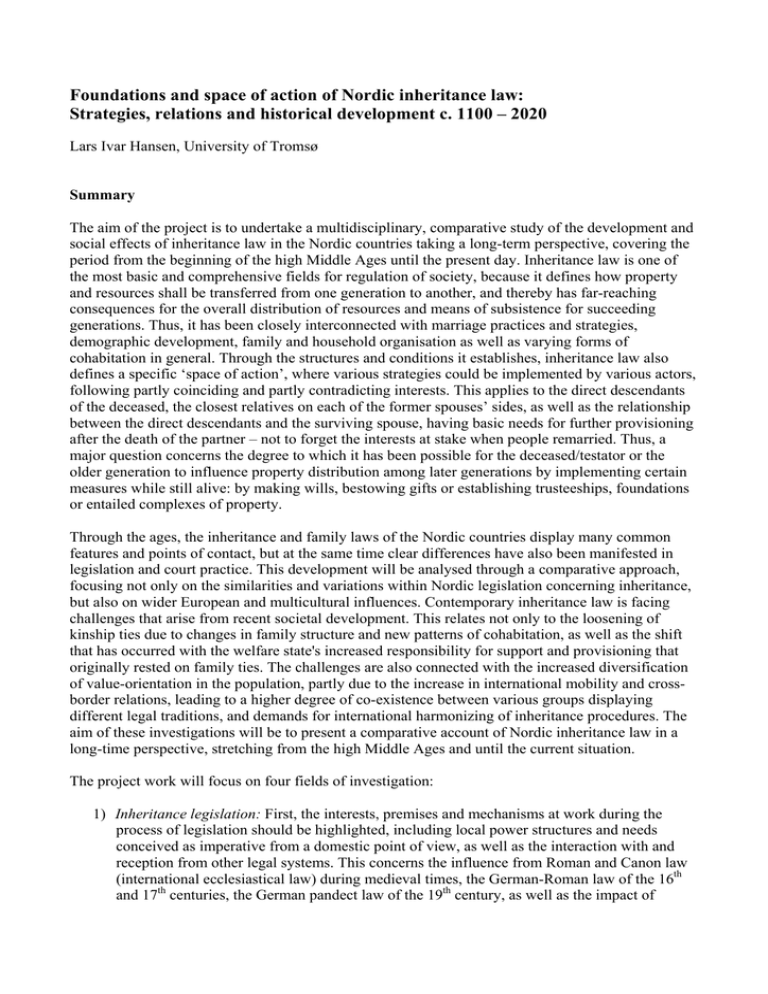
Foundations and space of action of Nordic inheritance law: Strategies, relations and historical development c. 1100 – 2020 Lars Ivar Hansen, University of Tromsø Summary The aim of the project is to undertake a multidisciplinary, comparative study of the development and social effects of inheritance law in the Nordic countries taking a long-term perspective, covering the period from the beginning of the high Middle Ages until the present day. Inheritance law is one of the most basic and comprehensive fields for regulation of society, because it defines how property and resources shall be transferred from one generation to another, and thereby has far-reaching consequences for the overall distribution of resources and means of subsistence for succeeding generations. Thus, it has been closely interconnected with marriage practices and strategies, demographic development, family and household organisation as well as varying forms of cohabitation in general. Through the structures and conditions it establishes, inheritance law also defines a specific ‘space of action’, where various strategies could be implemented by various actors, following partly coinciding and partly contradicting interests. This applies to the direct descendants of the deceased, the closest relatives on each of the former spouses’ sides, as well as the relationship between the direct descendants and the surviving spouse, having basic needs for further provisioning after the death of the partner – not to forget the interests at stake when people remarried. Thus, a major question concerns the degree to which it has been possible for the deceased/testator or the older generation to influence property distribution among later generations by implementing certain measures while still alive: by making wills, bestowing gifts or establishing trusteeships, foundations or entailed complexes of property. Through the ages, the inheritance and family laws of the Nordic countries display many common features and points of contact, but at the same time clear differences have also been manifested in legislation and court practice. This development will be analysed through a comparative approach, focusing not only on the similarities and variations within Nordic legislation concerning inheritance, but also on wider European and multicultural influences. Contemporary inheritance law is facing challenges that arise from recent societal development. This relates not only to the loosening of kinship ties due to changes in family structure and new patterns of cohabitation, as well as the shift that has occurred with the welfare state's increased responsibility for support and provisioning that originally rested on family ties. The challenges are also connected with the increased diversification of value-orientation in the population, partly due to the increase in international mobility and crossborder relations, leading to a higher degree of co-existence between various groups displaying different legal traditions, and demands for international harmonizing of inheritance procedures. The aim of these investigations will be to present a comparative account of Nordic inheritance law in a long-time perspective, stretching from the high Middle Ages and until the current situation. The project work will focus on four fields of investigation: 1) Inheritance legislation: First, the interests, premises and mechanisms at work during the process of legislation should be highlighted, including local power structures and needs conceived as imperative from a domestic point of view, as well as the interaction with and reception from other legal systems. This concerns the influence from Roman and Canon law (international ecclesiastical law) during medieval times, the German-Roman law of the 16th and 17th centuries, the German pandect law of the 19th century, as well as the impact of various Common Law traditions in recent times. 2) Wills, probate cases and court practice: Secondly, focus will be directed on how various actors have tried to promote their own purposes in relation to property devolution by the use of wills, marriage contracts and legal disputes. This should be studied in the context of various challenges posed by actual transformations of society, provoked by such factors as population increase, changing social stratification and family structure and the development of new forms of livelihood (e.g. as the result of industrialisation). 3) Property design: In addition, a series of measures has often been applied in order to meet particular requirements of the legators and their partners/families, relating to the desire to keep property or business complexes together and to prevent dispersal by default application of inheritance law. Special concerns for providing support and subsistence for the heirs and other relatives might also have played a role. These measures may be understood as particular cases of ‘property design’ and comprise such measures as the establishment of foundations, specifically entailed estates (fidei commissum), legacies, and pensions, as well as the ascription of usufructuary rights and rights to draw rent from specific property complexes. The use of trusteeships for minor heirs and the surviving spouse’s right to retain undivided possession of conjugal property should also be taken into consideration in this respect. Foundations and legacies are on the one hand a useful device for preserving property complexes, but may also cause problems when they are used for supporting families, because of the requirements of irrevocable separation and independent management. The aim is to study the varying application of such measures over time, and among different social strata. Of particular interest is the institution fidei commissum, which – based on European models – seems to have been introduced in the Nordic countries during the 17th century. 4) Status of persons and acting options: A fourth approach consists of studying the options for actions and possible strategies that might be followed by various actors, according to their status and the roles they are allotted in the process of property devolution; e.g. as married spouse, unmarried, or descendant – born either in or out of wedlock. More broadly, this concerns the individual status ascribed to particular persons: how they are regarded by the other actors, whether they are supposed to follow their own, individual interests, or whether they were conceived as representatives of the wider kinship group, expected to act in the interest of a particular kindred. Of particular interest in this respect is the occurrence of allodial rights (odal right) which was predominant in most Nordic countries – except Iceland – during Medieval and Early Modern times, and which gave certain members of a kin group the right of pre-emption and redemption of landed property that had been owned by members the same kindred for a minimum of time, defined by a specified number of generations or years. The project group consists of social and legal historians from all Nordic countries (Denmark, Finland, Iceland, Norway and Sweden). Arverettens forutsetninger og handlingsrom: Strategier, relasjoner og historisk utvikling ca. 1100 – 2020 Lars Ivar Hansen, Universitetet i Tromsø Sammenfatning Prosjektets overordnede siktemål er å gjennomføre komparative studier av nordisk arverett i et kronologisk perspektiv fra det tidspunkt de tidligste kildene er bevart, dvs. ca. 1100 og fram til dagens situasjon. I ethvert samfunn regulerer arveretten grunnleggende strukturer, ved at den etablerer regler og føringer for hvordan eiendom og disposisjonsrett til ressurser skal overføres ned gjennom generasjonene, og dermed har langtrekkende konsekvenser for fordelingen av produksjonsog eksistensgrunnlag for kommende generasjoner. Arveretten er dermed nært knyttet til ekteskapspraksis og giftermåls-strategier, demografisk utvikling og variasjoner i familie- og husholdsstruktur. Gjennom de strukturer som trekkes opp, definerer arveretten også et ’handlingsrom’, hvor forskjellige aktører kan søke å påvirke arvefordelingen ut fra ulike interesser. Dette kan gjelde livsarvinger, ektefellenes slektninger på begge sider og gjenlevende ektefelle, med sitt behov for å sikre underhold etter at partneren er gått bort – samt de dilemmaer som oppstår i tilfelle gjenlevende ektefelle ønsker å gifte seg på nytt. Det omfatter også tiltak fra arvelaterens side for å påvirke seinere eiendomsfordeling mens vedkommende ennå er i live, slik som testamenter, overdragelse av gaver og oppretting av særskilte stiftelser eller fond. Opp gjennom historien fremviser de nordiske land mange fellestrekk og berøringspunkter på familieog arverettens område, men samtidig foreligger det også klare forskjeller som har nedfelt seg i ulik lovgivning og rettspraksis. Et hovedmål vil derfor være å gjennomføre systematiske og komparative studier av den innbyrdes utvikling i de nordiske land, men dette vil også søkes sett i sammenheng med rettsutviklingen i sentrale europeiske land og økende grad av internasjonal og multikulturell innflytelse. Seinere tids samfunnsendringer synes i det hele tatt å stille aktuell arverettslovgivningen overfor utfordringer, ikke bare p.g.a. endringer av familiemønstre og samlivsformer, samt den forskyvning av grunnleggende ansvar for forsørgelse og underhold som er skjedd i takt med velferdsstatenes utvikling, men også med bakgrunn i økt internasjonal mobilitet, noe som i sin tur har ført til høyere grad av sameksistens mellom grupper med ulike verdisett og rettstradisjoner. – Disse studiene av nordisk arverett i et kombinert historisk og dagsaktuelt perspektiv er tenkt å munne ut i en samlet, integrert og komparativ fremstilling av arverettens historie gjennom perioden. Prosjektarbeidet vil bli strukturert omkring følgende fire hovedtema: 1) Arvelovgivningen: For det første tar en sikte på å klarlegge de prosesser, interesser og mekanismer som har medvirket ved lovgivningsprosessen, herunder også samvirke med og resepsjon fra andre lands rettssystemer. Dette gjelder innflytelsen fra så vel kanonisk rett (internasjonal kirkerett) i middelalderen, som den tysk-romerske retten på 1500-/1600-tallet, den tyske pandektretten på 1800-tallet og fra ’common law’-rettskulturer i dagens situasjon. 2) Testamenter, skifte- og rettspraksis: For det andre tar en sikte på å klarlegge ulike aktørers forsøk på tilpasse gjeldende lovgivning til egne interesser og aktuell samfunnsutvikling. Dette bør også sees i sammenheng med endrede samfunnsvilkår, knyttet til befolkningstilvekst, endret familiestørrelse, sosial lagdeling og industrialisering. 3) En vil også søke å kartlegge virkningene av andre initiativ for å ivareta arvelaters ønskemål og potensielle arvingers interesser, gjennom det som kan kalles ulike former for ”eiendomsdesign”. Slike initiativ kan omfatte opprettelse av stiftelser, fond, legater, pensjoner, mulighet til å sitte i uskiftet bo, bruk av vergemål, samt instituering av bruksrettigheter og rentegodtgjørelser. Innenfor noen nordiske lands rett reiser uskiftebo imidlertid problemer m.h.t. lengstlevende ektefelles adgang til å gifte seg på ny, samtidig som det synes å forutsette felleseie mellom ektefellene. Fond og stiftelser fremstår på den éne side som et velegnet instrument til at bevare formuer samlet, samtidig som de synes mindre velegnet når de søkes anvendt for forsørgelse og underhold av familier. For familier er det ofte vanskelig å ivareta lovgivningens krav om ugjenkallelig atskillelse samt uavhengige fondsstyrer. – Siktemålet er å studere variasjonen i tillempningen av slike tiltak over tid og mellom ulike sosiale lag, ikke minst institusjonen fideikomiss, som ut fra europeiske forbilder synes å ha blitt introdusert i de ulike nordiske land i løpet av 1600-tallet. 4) En siste tilnærming går ut på å undersøke det handlingsrom arveretten til enhver tid har definert, gjennom å ta utgangspunkt i personers status, og kartlegge hvilke handlingsmuligheter som forelå for de enkelte aktører ut fra hvilken rolle de innehadde i det forventede eller aktuelle arveoppgjøret: Som ektefelle, ugift partner eller barn født henholdsvis innenfor eller utenfor ekteskap. Herunder kommer forholdet mellom livsarvingene og gjenlevendes parts interesser (inkludert gjenlevendes krav på minstearv eller pliktdel), samt det mer generelle spørsmålet om hvorvidt personen ble oppfattet som et individ handlende ut fra egne interesser, eller som en representant for en slektsgruppe. – Av særskilt interesse er her odelsretten, som gjennom middelalder og tidlig nytid er kjent i alle nordiske land unntatt Island, og som på bestemte vilkår åpnet for gjenkjøpsrett av jord som var gått i arv innenfor for samme slektskrets i et bestemt antall generasjoner eller antall år. Forskergruppen består av historikere og jurister fra alle nordiske land (Danmark, Finland, Island, Norge og Sverige).
